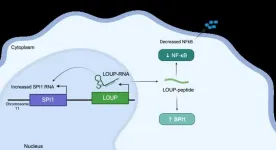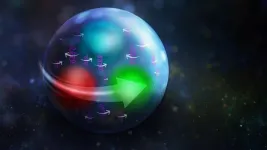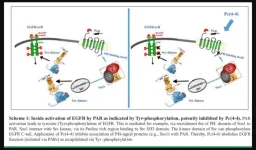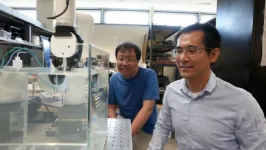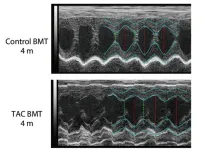(Press-News.org) A groundbreaking study, presented today at the 61st ERA Congress, has uncovered a significant breakthrough in the diagnosis and monitoring of kidney diseases associated with nephrotic syndrome.1
Using a hybrid technique, researchers identified anti-nephrin autoantibodies as a reliable biomarker for tracking disease progression, opening new avenues for personalised treatment approaches.
Nephrotic syndrome, characterised by elevated protein levels in the urine, is linked to kidney diseases such as minimal change disease (MCD), primary focal segmental glomerulosclerosis (FSGS), and membranous nephropathy (MN). The primary cause behind nephrotic syndrome is damage to podocytes, the cells responsible for filtering the kidneys, which allows protein to leak into the urine.2
Children diagnosed with MCD or FSGS often receive a diagnosis of idiopathic nephrotic syndrome (INS), where the cause of the nephrotic syndrome is unknown. This is frequently because children with high protein levels in their urine rarely undergo a kidney biopsy, which is how the cause is typically determined.3
Traditionally, diagnosing these conditions has posed challenges due to overlapping histological features and hesitancy to conduct invasive kidney biopsies, particularly in children. While anti-nephrin autoantibodies have been observed in certain patients with MCD and FSGS, their precise role in the advancement of these diseases is not fully understood.4,5
The study, conducted across Europe and the USA, introduced a novel approach combining immunoprecipitation with enzyme-linked immunosorbent assay (ELISA) to reliably detect anti-nephrin autoantibodies.
The findings revealed that anti-nephrin autoantibodies were prevalent in 69% of adults with MCD and 90% of children with INS who had not been treated with immunosuppressive drugs. Importantly, the levels of these autoantibodies correlated with disease activity, suggesting their potential as a biomarker for monitoring disease progression. The antibodies were also rarely seen in the other diseases under examination.
To further investigate the impact of nephrin immunisation on kidney function and disease, researchers administered laboratory-made nephrin protein to mice, creating a condition akin to MCD in the mice. Immunisation led to the phosphorylation of nephrin and notable alterations in cell structure, indicating the involvement of antibodies targeting nephrin in podocyte malfunction and nephrotic syndrome.
Remarkably, unlike other models necessitating multiple immunisations,6 this model induced swift disease manifestation with a single immunisation, even at low antibody concentrations.
Dr. Nicola M. Tomas, co-lead author of the study, commented, “The identification of anti-nephrin autoantibodies as a reliable biomarker, coupled with our hybrid immunoprecipitation technique, enhances our diagnostic capabilities and opens new avenues for closely monitoring disease progression in kidney disorders with nephrotic syndrome.”
Professor Tobias B. Huber, lead author of the study, furthered, “By providing insights into underlying mechanisms, these findings lay the groundwork for personalised interventions and pave the way for a new era of precision medicine for these complex conditions."
The study is being published today in the New England Journal of Medicine and presented at the 61st ERA Congress in Stockholm, Sweden.
Notes to editors:
A reference to the ERA Congress must be included in all coverage and/or articles associated with this study.
For more information or to arrange an expert interview, please contact press@era-online.org
About the lead study authors:
Professor Tobias B. Huber is a Professor of Medicine, Chair of the III. Department of Medicine at the University Medical Center Hamburg-Eppendorf, Director of the Hamburg Center for Kidney Health and President of the International Society of Glomerular disease.
Dr. Nicola M. Tomas is a Senior Attending Physician and Principle Investigator at the III. Department of Medicine at the University Medical Center Hamburg-Eppendorf.
About the European Renal Association (ERA):
With more than 18,000 active members, the ERA is one of the biggest nephrology associations worldwide leading European nephrology, and one of the most important European Medical Associations. It organises annual congresses and other educational and scientific activities. The ERA also collects data and performs epidemiological studies through its Registry. The Society supports fellowships and educational/research projects through its committees and working groups. Its publications are NDT, CKJ (Open Access journal), and the online educational portal NEP.
The 61st ERA Congress takes place between 23-26 May 2024, both virtually and live in Stockholm, Sweden.
Website: www.era-online.org
References:
Autoantibodies Targeting Nephrin in Podocytopathies, Huber T. B (2024). Presented at the ERA Congress 2024.
Tapia, C., & Bashir, K. (2023). Nephrotic Syndrome. In StatPearls. StatPearls Publishing.
Eddy, A. A., & Symons, J. M. (2003). Nephrotic syndrome in childhood. Lancet (London, England), 362(9384), 629–639. https://doi.org/10.1016/S0140-6736(03)14184-0
Watts, A. J. B., Keller, K. H., Lerner, G., Rosales, I., Collins, A. B., Sekulic, M., Waikar, S. S., Chandraker, A., Riella, L. V., Alexander, M. P., Troost, J. P., Chen, J., Fermin, D., Yee, J. L., Sampson, M. G., Beck, L. H., Jr, Henderson, J. M., Greka, A., Rennke, H. G., & Weins, A. (2022). Discovery of Autoantibodies Targeting Nephrin in Minimal Change Disease Supports a Novel Autoimmune Etiology. Journal of the American Society of Nephrology: JASN, 33(1), 238–252. https://doi.org/10.1681/ASN.2021060794
Shirai, Y., Miura, K., Ishizuka, K., Ando, T., Kanda, S., Hashimoto, J., Hamasaki, Y., Hotta, K., Ito, N., Honda, K., Tanabe, K., Takano, T., & Hattori, M. (2024). A multi-institutional study found a possible role of anti-nephrin antibodies in post-transplant focal segmental glomerulosclerosis recurrence. Kidney international, 105(3), 608–617. https://doi.org/10.1016/j.kint.2023.11.022
Seifert, L., Zahner, G., Meyer-Schwesinger, C., Hickstein, N., Dehde, S., Wulf, S., Köllner, S. M. S., Lucas, R., Kylies, D., Froembling, S., Zielinski, S., Kretz, O., Borodovsky, A., Biniaminov, S., Wang, Y., Cheng, H., Koch-Nolte, F., Zipfel, P. F., Hopfer, H., Puelles, V. G., Tomas, N. M. (2023). The classical pathway triggers pathogenic complement activation in membranous nephropathy. Nature communications, 14(1), 473. https://doi.org/10.1038/s41467-023-36068-0 END
New technique detects novel biomarkers for kidney diseases with nephrotic syndrome
A study, presented at the 61st ERA Congress, has uncovered a significant breakthrough in the diagnosis and monitoring of kidney diseases associated with nephrotic syndrome
2024-05-25
ELSE PRESS RELEASES FROM THIS DATE:
Political elites take advantage of anti-partisan protests to disrupt politics
2024-05-24
Protest movements that reject political parties have an unintended consequence, according to new research from the University of Notre Dame: They empower savvy politicians who channel them to shake up the status quo.
The findings provide a framework for understanding recent global political realignments and offer lessons for activists who want to make a meaningful impact. They are particularly relevant in an era when mass protests have become an increasingly common tool to voice dissent with powerful institutions and draw attention to overlooked issues ranging from climate and conflict ...
Tiny target discovered on RNA to short-circuit inflammation, UC Santa Cruz researchers find
2024-05-24
UC Santa Cruz researchers have discovered a peptide in human RNA that regulates inflammation and may provide a new path for treating diseases such as arthritis and lupus. The team used a screening process based on the powerful gene-editing tool CRISPR to shed light on one of the biggest mysteries about our RNA–the molecule responsible for carrying out genetic information contained in our DNA.
This peptide originates from within a long non-coding RNA (lncRNA) called LOUP. According to the researchers, ...
Charge your laptop in a minute? Supercapacitors can help; new research offers clues
2024-05-24
Imagine if your dead laptop or phone could charge in a minute or if an electric car could be fully powered in 10 minutes.
While not possible yet, new research by a team of CU Boulder scientists could potentially lead to such advances.
Published today in the Proceedings of the National Academy of Sciences, researchers in Ankur Gupta’s lab discovered how tiny charged particles, called ions, move within a complex network of minuscule pores. The breakthrough could lead to the development of more efficient energy storage devices, such as supercapacitors, said Gupta, an assistant professor of chemical and biological engineering.
“Given the critical role ...
Scientists discover CO2 and CO ices in outskirts of solar system
2024-05-24
ORLANDO, May 24, 2024 – For the first time, carbon dioxide and carbon monoxide ices have been observed in the far reaches of our solar system on trans-Neptunian objects (TNOs).
A research team, led by planetary scientists Mário Nascimento De Prá and Noemí Pinilla-Alonso from the University of Central Florida’s Florida Space Institute (FSI), made the findings by using the infrared spectral capabilities of the James Webb Space Telescope (JWST) to analyze the chemical composition of 59 trans-Neptunian objects and Centaurs.
The pioneering study, published ...
Theory and experiment combine to shine a new light on proton spin
2024-05-24
NEWPORT NEWS, VA – Nuclear physicists have long been working to reveal how the proton gets its spin. Now, a new method that combines experimental data with state-of-the-art calculations has revealed a more detailed picture of spin contributions from the very glue that holds protons together. It also paves the way toward imaging the proton’s 3D structure.
The work was led by Joseph Karpie, a postdoctoral associate in the Center for Theoretical and Computational Physics (Theory Center) at the U.S. Department of Energy's Thomas Jefferson National Accelerator Facility.
He said that this decades-old mystery began with measurements of the sources of the proton’s spin in ...
PKMYT1, a potential ‘Achilles heel’ of treatment resistant ER+ breast cancers with the poorest prognosis
2024-05-24
Up to 80% of breast cancer deaths occur in patients with tumors that express estrogen receptor-alpha. Although these estrogen receptor-positive (ER+) breast cancers often initially respond to standard treatment that combines endocrine therapies with CDK4/6 inhibitors, drug resistance often develops leading to lethal metastatic disease that spreads from the breast and does not respond to available treatments.
Looking to identify new vulnerabilities in this type of cancer that could lead to improved therapies, ...
PH-binding motifs as a platform for drug design: Lessons from protease-activated receptors (PARs)
2024-05-24
“We have identified binding motifs within the C-tails of PAR1,2&4, indispensable for cancer growth and development.”
BUFFALO, NY- May 24, 2024 – A new editorial paper was published in Oncoscience (Volume 11) on April 25, 2024, entitled, “PH-binding motifs as a platform for drug design: Lessons from protease-activated receptors; PARs.”
While targeted cancer therapy is greatly dependent on specific oncogenic pathways or conferred by genetic alterations, it remains yet challenging and somewhat disappointing. The high level of failure relies ...
Virginia Tech researcher creates new tool to move tiny bioparticles
2024-05-24
Undergoing surgery is seldom a pleasant experience, and it can sometimes be highly invasive. Surgical procedures have evolved steadily over the centuries, growing with the knowledge of anatomy and biology.
Innovative methods have also been bolstered with new tools, and a growth in the use of robotics since the 1980s has moved health care forward significantly. Assistant Professor Zhenhua Tian has pressed forward another step in the march of progress using robotics and noninvasive acoustics, and his team’s work has been published in Science Advances.
Robot-assisted surgery
Surgery using robots has been invasive since its invention because ...
On repeat: Biologists observe recurring evolutionary changes, over time, in stick insects
2024-05-24
LOGAN, UTAH, USA – A long-standing debate among evolutionary scientists goes something like this: Does evolution happen in a predictable pattern or does it depend on chance events and contingency? That is, if you could turn back the clock, as celebrated scientist Stephen Jay Gould (1941-2002) described in his famous metaphor, “Replaying the Tape of Life,” would life on Earth evolve, once again, as something similar to what we know now, or would it look very, very different?
“If you frame it as an either/or question, it’s too simplistic,” says Utah State University evolutionary biologist Zachariah Gompert. “The answer isn’t ‘completely ...
Understanding a broken heart
2024-05-24
The stress of heart failure is remembered by the body and appears to lead to recurrent failure, along with other related health issues, according to new research. Researchers have found that heart failure leaves a “stress memory” in the form of changes to the DNA modification of hematopoietic stem cells, which are involved in the production of blood and immune cells called macrophages. These immune cells play an important role in protecting heart health. However, a key signaling pathway (a chain of molecules which ...
LAST 30 PRESS RELEASES:
University of Phoenix College of Doctoral Studies releases white paper on AI-driven skilling to reduce burnout and restore worker autonomy
AIs fail at the game of visual “telephone”
The levers for a sustainable food system
Potential changes in US homelessness by ending federal support for housing first programs
Vulnerability of large language models to prompt injection when providing medical advice
Researchers develop new system for high-energy-density, long-life, multi-electron transfer bromine-based flow batteries
Ending federal support for housing first programs could increase U.S. homelessness by 5% in one year, new JAMA study finds
New research uncovers molecular ‘safety switch’ shielding cancers from immune attack
Bacteria resisting viral infection can still sink carbon to ocean floor
Younger biological age may increase depression risk in older women during COVID-19
Bharat Innovates 2026 National Basecamp Showcases India’s Most Promising Deep-Tech Ventures
Here’s what determines whether your income level rises or falls
SCIE indexation achievement: Celebrate with Space: Science & Technology
Children’s Hospital Colorado performs region’s first pediatric heart and liver dual organ transplant
Australian team discover why quantum computers have memory problems over time
What determines the fate of a T cell?
Candida auris: genetic process revealed which could be treatment target for deadly fungal disease
Groundbreaking discovery turns household plastic recycling into anti-cancer medication
Blocking a key inflammatory pathway improves liver structure and vascular function in cirrhosis, study finds
Continuous spread: Raccoon roundworm detected in nine European countries
HKUST Engineering researchers developed a novel photodetector to enhance the performance of on-chip light monitoring
Strategic river sensors could have forewarned of Texas Camp flood disaster
Drone sampling of whale breath reveals first evidence of potentially deadly virus in Arctic
Roman soldiers defending Hadrian’s Wall infected by parasites, study finds
Pinochet’s prisoners were tormented with music but still found solace in it, a new book reveals
Fertility remains high in rural Tanzania despite access to family planning
AI-assisted device can improve autism care access
Kinetic careers
Uncovering how parasitic plants avoid attacking themselves to improve crop resistance
Nanoparticle vaccine strategy could protect against Ebola and other deadly filoviruses
[Press-News.org] New technique detects novel biomarkers for kidney diseases with nephrotic syndromeA study, presented at the 61st ERA Congress, has uncovered a significant breakthrough in the diagnosis and monitoring of kidney diseases associated with nephrotic syndrome

